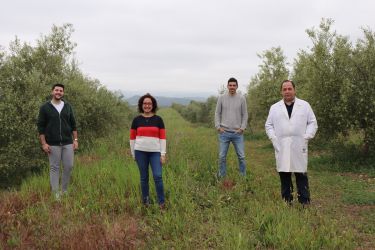The UCO team from the Diverfarming project study the short- medium- and long-term changes in the organic carbon content in the soil, comparing conventional practices, no tilling and plant cover
The index of stratification of organic carbon in soil is used as an indicator of soil quality. This parameter offers information on the fertility of a specific zone and its capacity to support different agricultural activities, as well as the productivity of its crops.
In this way, it is possible to know the quality of a soil from its organic carbon content and from its stratification index. This has been the starting point for the research group, SUMAS, formed by Luis Parras, Beatriz Lozano, Jesús Aguilera and Manuel González, from the Department of Agricultural Chemistry, Edaphology and Microbiology at the University of Cordoba, Spain, who have studied different soil management systems and their effects in the short and medium-long term to determine the changes in the organic carbon in the soils.
 Their research has centred on a Mediterranean centenary dryland olive grove, located in the countryside of Jaen, in order to assess the extent of degradation and identify the best practices to achieve sustainable use of the soil.
Their research has centred on a Mediterranean centenary dryland olive grove, located in the countryside of Jaen, in order to assess the extent of degradation and identify the best practices to achieve sustainable use of the soil.
Three types of practices have been trialled in this study, for different periods of time. On the one hand, conventional practices were applied on a plot from 2003 to 2017, where the evolution in the quality in the medium-long term was observed. “Here we found very little variation because the problem of Mediterranean soils is that the amount of carbon they have is very low due to the climate”, highlighted Luis Parras, researcher for the project and professor in Agricultural Chemistry and Edaphology at the UCO.
Likewise, the same period of 14 years was studied in plots where no tilling was applied but herbicides were used to control the weeds, and it was observed that the surface had lost quality. Although they were able to observe an increase in that quality from the bottom towards the top, “something good because it means that the carbon is stabilised at depth and, with that, we manage to eliminate carbon from the atmosphere and that it will not escape again, as opposed to if it were on the surface”, added Parras.
These were the practices which traditionally have been most used in management of an olive grove. However, this research group has also studied the introduction of plant cover, within the European Diverfarming project, which seeks a change in paradigm in European agriculture towards an agriculture which is environmentally and economically more sustainable through crop diversification and the use of low-input farming practices. The result has been positive when checking that in scarcely two years a slight improvement in the trend of the soil quality has been noted.
This practice was implemented between 2017 and 2019 and a significant change was observed which fuels expectations for the future. “This is rather important because if in the short term we start to see a slight improvement that means that if it is kept over time it could become much more important”, indicated Parras.
This increase in quality has been possible thanks to the plant cover which has enabled the carbon on the surface to move down, which is what the research group seeks, since carbon that stays on the surface - as occurs in conventional farming practices - is easily dragged by torrential rain and damaged by the high temperatures typical of the study zone. However, if the agricultural community uses practices which are able to capture carbon in the deepest layers of the soil it ensures that this will remain there over time, thereby avoiding greenhouse gases in the atmosphere.
Diverfarming is a project financed by the Horizon 2020 Programme of the European Commission, within the challenge of “Food Security, Sustainable Agriculture and Forestry, Marine, Maritime and Inland Water Research and the Bioeconomy” under agreement 728003, and which counts on the participation of the Universities of Cartagena and Córdoba (Spain), Tuscia (Italy), Exeter and Portsmouth (United Kingdom), Wageningen (Netherlands), Trier (Germany), Pecs (Hungary) and ETH Zurich (Switzerland), the research centres Consiglio per la ricerca in agricoltura e l'analisi dell'economia agraria (Italy), the Consejo Superior de Investigaciones Científicas (Spain) and the Natural Resources Institute LUKE (Finland), the agrarian organisation ASAJA, and the companies Casalasco and Barilla (Italy), Arento, LogísticaDFM and Industrias David (Spain), Nieuw Bromo Van Tilburg and Ekoboerdeij de Lingehof (Netherlands), Weingut Dr. Frey (Germany), Nedel-Market KFT and Gere (Hungary) and Paavolan Kotijuustola and Polven Juustola (Finland).
References
Aguilera-Huertas, J.; Lozano-García, B.; González-Rosado, M.; Parras-Alcántara, L. Effects of Management and Hillside Position on Soil Organic Carbon Stratification in Mediterranean Centenary Olive Grove. Agronomy 2021, 11, 650. https://doi.org/10.3390/agronomy11040650










